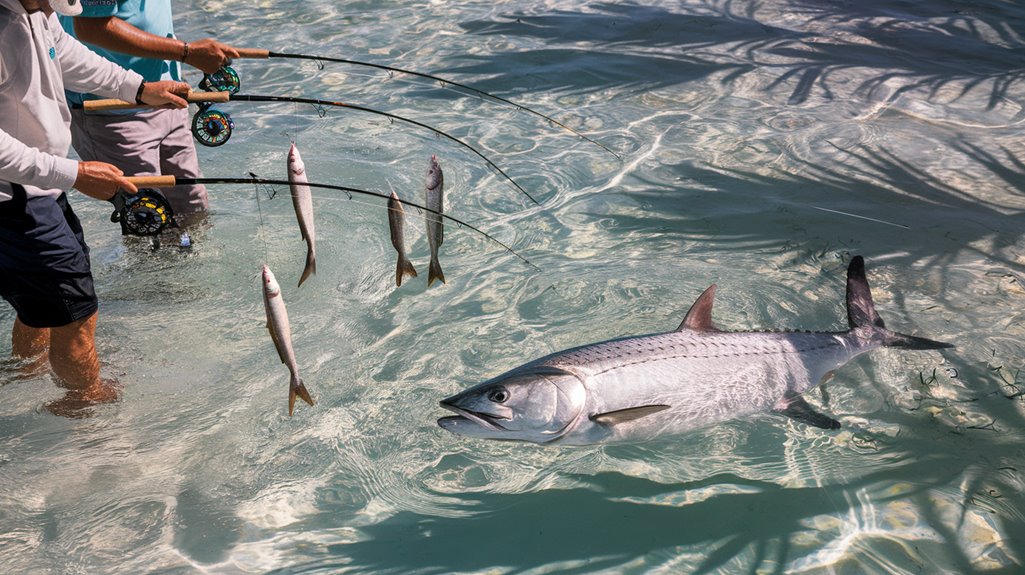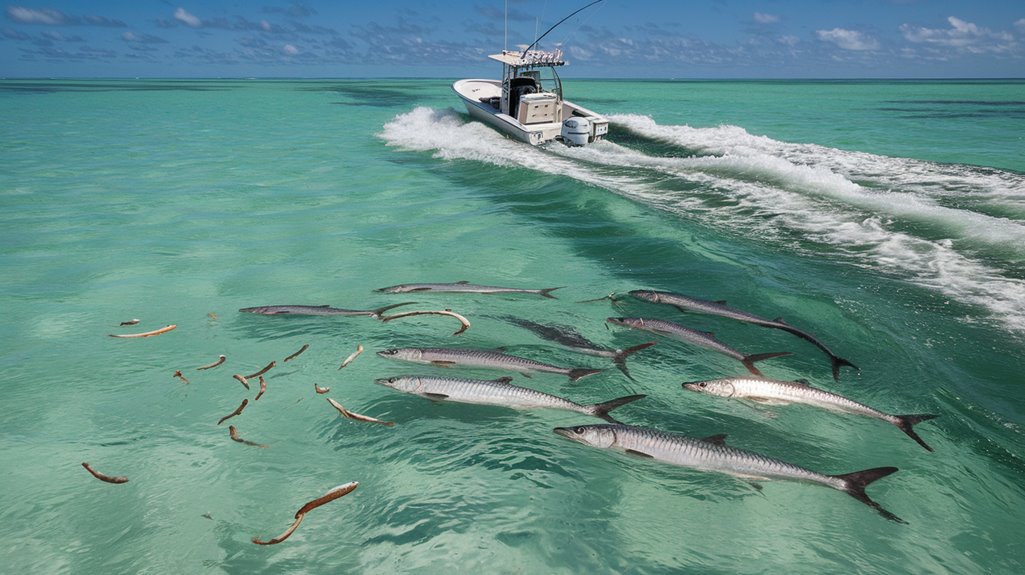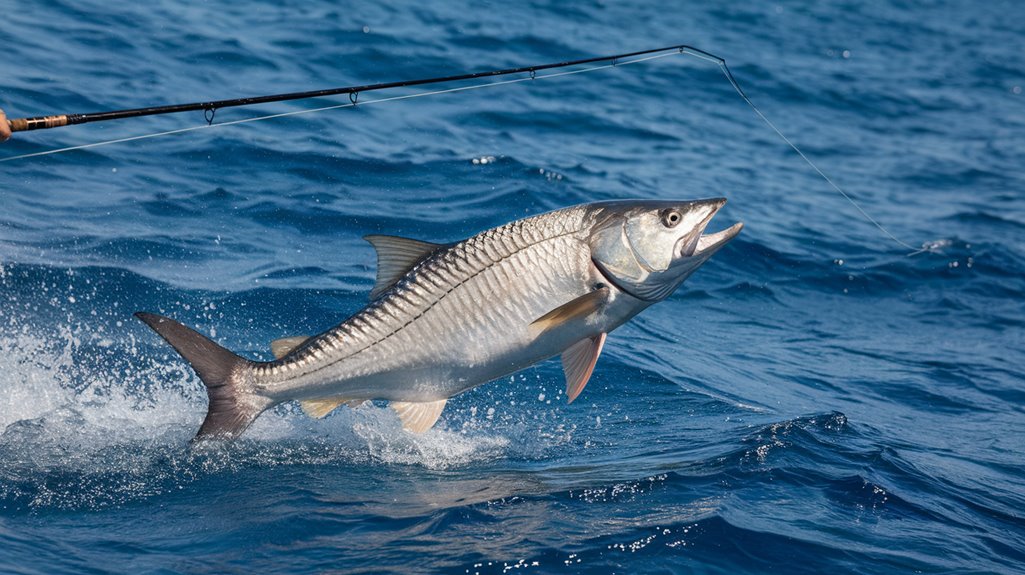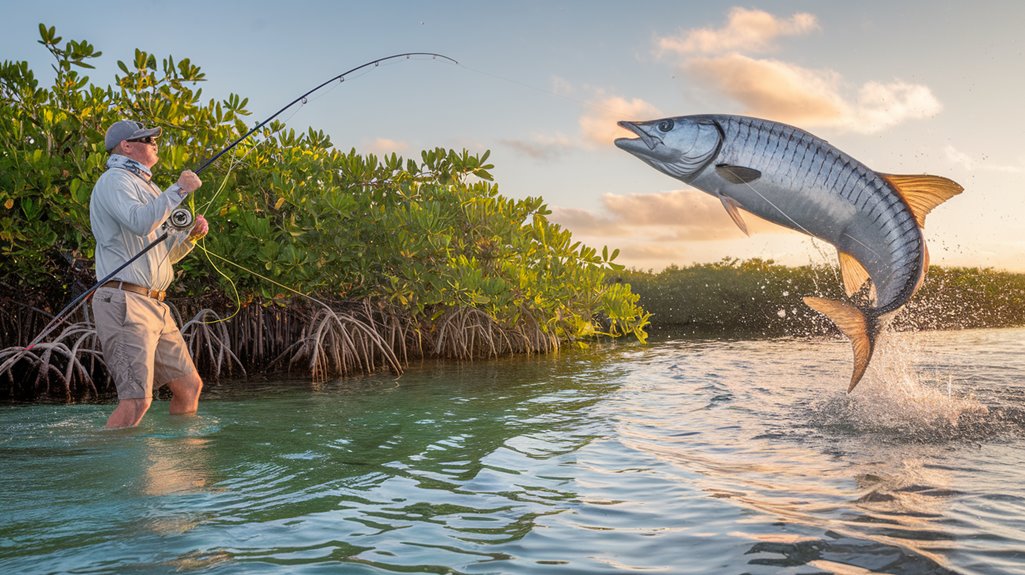You've probably spent countless hours dreaming of landing a trophy tarpon, but if you're making common mistakes, that dream can quickly turn into frustration. From selecting the wrong bait to mishandling your boat's approach, these errors can spell the difference between success and watching that silver king swim away. Let's examine the vital missteps that separate novice anglers from seasoned pros, and discover how to avoid them.
Key Takeaways
- Using dead or lifeless bait instead of properly presented live mullet and crabs that match local tarpon population size.
- Setting hooks too aggressively rather than maintaining steady pressure with controlled movements and proper circle hook techniques.
- Positioning boats too close to other vessels or running loud engines that spook nearby tarpon.
- Utilizing inadequate equipment, including undersized rods, weak leaders, or reels not designed for heavy-fighting scenarios.
- Failing to properly fight hooked tarpon by high-sticking rods and not bowing to jumping fish.
Poor Bait Selection and Presentation

Bait selection and presentation can make or break your tarpon fishing success. Poor bait selection, like using dead or improperly presented bait, won't entice these selective predators that prefer live mullet and crabs matching their natural food sources. You'll need to carefully match the size of bait to your local tarpon population – larger fish demand bigger offerings, while smaller ones require scaled-down options.
Your rigging techniques must allow for natural movement, avoiding excessive weight or improper hook sizes that restrict bait action. When presenting your bait, remember to cast away from the boat to prevent spooking these wary fish. Pay attention to current and tide patterns, as they influence feeding zones. Position your bait to drift naturally through these areas, maximizing your chances of connecting with feeding tarpon.
Improper Hook Setting Techniques
Setting the hook properly stands as one of the most critical skills in tarpon fishing, yet it's where many anglers fall short. You'll want to avoid aggressive hook setting, which often leads to pulled hooks and missed opportunities to catch a tarpon. Instead, maintain steady pressure on the fish with a controlled thump.
When using circle hooks, keep your rod tip pointed directly at the fish, allowing it to swim away and set the hook naturally. Don't create slack line by reeling too soon after feeling the bite. Wait for firm pressure before lifting your rod tip to 45 degrees. Remember to adjust your technique based on your bait choice – live crabs require a gentler pull compared to mullet. Once the fish is hooked, maintain consistent pressure to secure your catch.
Boat Positioning and Fish Approach

While mastering hook setting techniques puts you closer to landing tarpon, proper boat positioning can make or break your success before you even cast a line. When approaching tarpon schools, you'll want to use your trolling motor instead of the main engine to maintain a quiet presence. Anchor upcurrent and let your bait drift naturally into feeding zones.
| Positioning Factor | Common Mistake | Correct Approach |
|---|---|---|
| Motor Usage | Running loud engine | Use trolling motor |
| Distance | Too close to others | Stay 300+ yards away |
| Current | Fighting the flow | Position with current |
Always monitor wind and current conditions to optimize your boat's position. You'll find that tarpon typically swim with the current, so positioning yourself accordingly will greatly increase your chances of a successful catch.
Equipment and Tackle Failures
Poor equipment choices can quickly derail your tarpon fishing adventure, no matter how skilled you are at spotting and approaching these magnificent fish. Your success hinges on selecting the right tackle and maintaining its integrity throughout the fight.
Key equipment failures that'll cost you fish include:
- Using undersized rods (you'll need at least a 10-weight) leading to break-offs
- Choosing weak fluorocarbon leaders that can't handle powerful jumps
- Selecting reels that aren't designed for heavy-fighting scenarios
Don't overlook the importance of knot strength – a single weak connection can end your fight instantly. You'll also need to match local recommendations for fly patterns and bait sizes. Remember, tarpon fishing demands specialized equipment that's up to the challenge of battling these powerful gamefish.
Fighting and Landing Errors

Landing a trophy tarpon demands precise technique during the fight, as even minor errors can result in lost fish after hours of pursuit. When you fight the fish, avoid high sticking your rod and line near the boat, as this leads to line breakage. Instead, maintain pressure by keeping your rod horizontal to the water column. Experienced tarpon anglers know to bow to the king when the fish jumps, giving them slack by lowering the rod tip. You'll need to adjust drag continuously based on the fish's behavior – too much tension can snap the line, while too little lets them escape. Keep your rod pointed at the fish to absorb surges, and avoid reeling in too aggressively after the strike. A steady, rhythmic retrieve will secure the hook more effectively.
Frequently Asked Questions
Why Are Tarpon so Hard to Catch?
You'll find tarpon challenging because they're highly sensitive to disturbances, exhibit unpredictable feeding patterns, and require precise technique during fights due to their size and powerful jumping abilities.
How to Keep Tarpon Hooked?
Keep steady pressure, bow when they jump, and don't high-stick your rod. You'll want to use circle hooks, maintain proper drag settings, and point your rod directly at the fish initially.
What Is the Best Way to Catch Tarpon?
You'll catch more tarpon using live mullet or crabs during early morning hours. Keep quiet, approach slowly with your trolling motor, and let them take the bait before gently lifting your rod.
What Should You Not Do While Fishing?
Don't spook fish with loud noises or shadows, avoid anchoring too close to schools, don't fish from incorrect angles, and never chase after moving tarpon that are showing signs of distress.
Conclusion
When you're targeting tarpon, don't let common mistakes derail your success. By selecting fresh, properly rigged bait, maintaining a controlled hook set, positioning your boat strategically, and using appropriate tackle, you'll greatly improve your odds. Remember to avoid high sticking during the fight and stay patient with these magnificent gamefish. Master these fundamentals, and you'll convert more hookups into successful catches.

